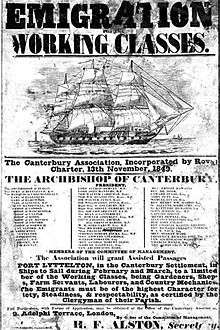Canterbury Association
The Canterbury Association was formed in order to establish a colony in what is now the Canterbury region in the South Island of New Zealand.
Formation of the Association
The Association, founded in London on 27 March 1848, was incorporated by Royal Charter on 13 November 1849. The prime movers were Edward Gibbon Wakefield and John Robert Godley. Wakefield was heavily involved in the New Zealand Company, which by that time had already established four other colonies in New Zealand (Wellington, Nelson, Petre and Otago). Wakefield approached Godley to help him establish a colony sponsored by the Church of England. John Sumner (the Archbishop of Canterbury) served as the President of the Association's Committee of Management, and the Committee itself included several other bishops and clergy, as well as members of the peerage and Members of Parliament.[1] At its first meeting the Association decided upon names. The settlement was to be called "Canterbury" (presumably after the Archbishop of Canterbury), the seat of the settlement "Christchurch" (after the Oxford college Christ Church, at which Godley had studied).
Establishment of the colony

The Association re-targeted its planned settlement from the Wairarapa to the Banks Peninsula hinterland,[2] where it arranged to buy land from the New Zealand Company for 10 shillings per acre (4000 m²). The Association then sold the land to its colonists for £3 per acre, reserving the rest, the additional £2 10s, for use in "public objects such as emigration, roads, and Church and school endowments" (20 shillings = £1). The provision of funds for emigration allowed the Association to offer assisted passages to members of the working classes with desirable skills for the new colony. A poster advertising the assisted passages specifically mentions "Gardeners, Shep[herd]s, Farm Servants, Labourers and Country Mechanics". The religious nature of the colony shows in the same poster's requirement that the clergyman of their parish should vouch for applicants, and in the specific earmarking of some of the proceeds from land sales for church endowments.[3]
Godley (with his family) went out to New Zealand in early 1850 to oversee the preparations for the settlement (surveying, roads, accommodation, etc.) already undertaken by a large team of men under the direction of Captain Joseph Thomas. These preparations were advanced, but incomplete when the first ships of settlers arrived on 16 December 1850 – Godley halted them shortly after his arrival in April due to the mounting debts of the Association. Lord Lyttelton, Sir John Simeon, 3rd Baronet, Edward Gibbon Wakefield, and Lord Richard Cavendish guaranteed ₤15,000 to the Association, which saved it from financial collapse.[4]
Charlotte Jane and Randolph arrived in Lyttelton Harbour on 16 December 1850, Sir George Seymour on the 17th, and Cressy on the 27th, having set sail from England in September 1850. The British press dubbed the settlers on these first four ships Canterbury Pilgrims. A further 24 shiploads of Canterbury Association settlers, making a total of approximately 3,500, arrived over the next two-and-a-half years.[1]
In 1852, the Parliament of the United Kingdom passed the New Zealand Constitution Act 1852, which amongst other things established provincial councils. The Constitution contained specific provisions for the Canterbury Association; the first being that the new General Assembly (New Zealand Parliament) could not amend the legislation establishing the Canterbury Association,[5] the second being that the Canterbury Association could hand its powers to a newly-established provincial government (the Canterbury Province).[6]
As a result, affairs of the Canterbury Association were wound up in 1855 and outstanding settlement lands handed over to the Canterbury Province.[7]
See also
References
- Canterbury Association.
-
Harrop, A. J. (1961). "The Companies and British Sovereignty, 1825–1850". In Dodwell, Henry Herbert; Rose, John Holland (eds.). The Cambridge History of the British Empire. 2. CUP Archive. p. 89. Retrieved 26 June 2013.
[...] Lord Grey consented to instruct the Governor to procure for the Association about a million acres, at or near the Wairarapa Plains if possible. Meanwhile the Governor had acquired the land between Nelson and Otago for £2000, and it was in part of this district that the Canterbury settlement was eventually formed.
- Hearn, Terry (25 March 2015). "Canterbury Association advertisement". Teara, the Encyclopedia of New Zealand. Government of New Zealand. Retrieved 14 December 2017.
- Blain, Rev. Michael (2007). The Canterbury Association (1848–1852): A Study of Its Members’ Connections (PDF). Christchurch: Project Canterbury. pp. 18–19. Retrieved 14 October 2012.
- Constitution Act 1852, Section 75.
- Constitution Act 1852, Section 76.
- "Canterbury Association's Ordinance 1855". New Zealand Legal Information Institute. Retrieved 5 April 2019.
Further reading
- "New Zealand Constitution Act 1852". Victoria University of Wellington – New Zealand Electronic Text Collection. 30 June 1852. Retrieved 2 April 2019.
- Terry Hearn. 'English', Te Ara — the Encyclopedia of New Zealand, updated 11-Jul-2005.
- Philip Temple. 'A sort of conscience: the Wakefields' Auckland University Press (2002). ISBN 1-86940-276-6
- Hensley, Gerald. "Godley, John Robert 1814–1861". Dictionary of New Zealand Biography. Ministry for Culture and Heritage. Retrieved 3 April 2011.
External links
| Wikisource has original text related to this article: |
| Wikimedia Commons has media related to Canterbury Association. |